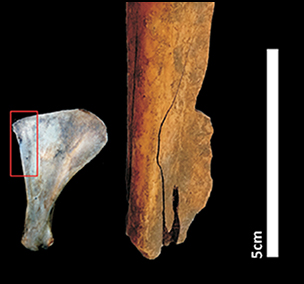Crossref Citations
This article has been cited by the following publications. This list is generated based on data provided by
Crossref.
Medina, Matías E.
Campos, Mailín
Ávila, Nancy
Soibelzon, Esteban
and
Fernández, Fernando J.
2019.
Animal food during the Late Prehispanic Period at Sierras of Córdoba, Argentina. A zooarchaeological view from Boyo Paso 2.
Anthropozoologica,
Vol. 54,
Issue. 1,
p.
83.
Bradfield, Justin
2019.
Fishing with gorges: Testing a functional hypothesis.
Journal of Archaeological Science: Reports,
Vol. 24,
Issue. ,
p.
593.
Medina, Matías E.
Picasso, Mariana B.J.
Campos, Mailín R.
and
Avila, Nancy C.
2019.
Tarsometatarsus, eggshells, and the species level identification of large‐sized flightless birds from Boyo Paso 2 (Sierras of Córdoba, Argentina).
International Journal of Osteoarchaeology,
Vol. 29,
Issue. 4,
p.
584.
Medina, Matías E.
López, M. Laura
Campos, Mailín R.
Palmieri, Valentina Saur
and
Pastor, Sebastián
2020.
Pit-houses, seasonality, and subsistence resources: an essay from Boyo Paso 2 (ca. 900–700 BP, Sierras of Córdoba, Argentina).
Archaeological and Anthropological Sciences,
Vol. 12,
Issue. 6,
Medina, Matías E.
and
Balena, Imanol
2021.
Ancient Hunting Strategies in Southern South America.
p.
33.
Desmond, Abigail
Cartwright, Ian
and
Allen, Richard
2021.
Documenting Functional Use-Wear on Bone Tools: An RTI Approach.
Journal of Computer Applications in Archaeology,
Vol. 4,
Issue. 1,
p.
214.
Medina, Matías E.
Sario, Gisela
and
Pastor, Sebastián
2022.
Bone spearheads from the Late Prehispanic Period of Sierras of Cordoba (Argentina).
International Journal of Osteoarchaeology,
Vol. 32,
Issue. 4,
p.
759.
Bradfield, Justin
2022.
Scales of Analysis: the Usage of Appropriate Magnification in Use-Wear Studies.
Arheologia,
p.
5.
Desmond, Abigail
2022.
Bone Tool Proxy Evidence for Coiled Basketry Production in the North African Palaeolithic.
Journal of African Archaeology,
Vol. 20,
Issue. 2,
p.
156.
Medina-López, Sandra Viviana
Zuluaga-Domínguez, Carlos Mario
Fernández-Trujillo, Juan Pablo
and
Hernández-Gómez, María Soledad
2022.
Nonconventional Hydrocolloids’ Technological and Functional Potential for Food Applications.
Foods,
Vol. 11,
Issue. 3,
p.
401.
Alaica, Aleksa K.
and
Bélisle, Véronique
2023.
Bone and antler artifact use in the 1st millennium CE of Cusco, Peru: Insights on textile production and food processing from the site of Ak'awillay.
Quaternary International,
Vol. 665-666,
Issue. ,
p.
176.
Osipowicz, Grzegorz
Orłowska, Justyna
Cristiani, Emanuela
Bosiak, Mariusz
Kubiak-Martens, Lucy
Czebreszuk, Janusz
Makowiecki, Daniel
and
Groman-Yaroslavski, Iris
2024.
Notched implements made of scapulae (Bruszczewo-type tools)—A problem solved? Discovering cereal- and legume-threshing techniques in Early Bronze Age Europe through traceological analysis and residue studies.
PLOS ONE,
Vol. 19,
Issue. 9,
p.
e0308700.
Bradfield, Justin
2024.
Encyclopedia of Archaeology (Second Edition).
p.
406.
DiBattista, Adam
2025.
Worked Bone, Antler, Ivory, and Keratinous Materials.



